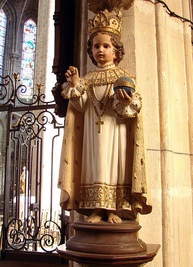
Infant Jesus of Prague
The renowned statue of the Infant Jesus of Prague, known in catholic countries by the name Bambino di Praga, was placed in the Church of Our Lady Victorious in the Lesser Quarter of Prague in 1628. The bride of Vratislas of Pernstein, Maria Maximiliana Manriquez de Lara, brought the statuette to Bohemia in the middle of the 16th century. She later gave it to her daughter Polyxena, who was to marry William of Rosenberg, as a wedding gift for the protection of their home. After the death of William, Polyxena only gave birth to a son, Wenceslas Eusebia, in a second marriage with Zdenek Popel of Lobkowitz. According to the tradition, the statuette was to be gifted to a daughter, so Polyxena gave it to the order of the Carmelites. Later, the statuette became the subject of myths about miraculous help during the plague, during plundering etc., due to the convent remaining untouched on several such occasions. The statuette was lost during the Thirty Years War and was found in 1638 behind the church altar with broken arms, which had to be repaired. In 1651 it was carried during a procession through Prague and received the epithet Holy Infant Jesus. After the convent was abolished, the Infant Jesus was entrusted to the order of the Loreto sisters. People have always
turned to the statuette for help and it is mainly venerated in Spain, in Italy, in Latin-American countries and in the Philippines. A copy of the Infant Jesus was given as a gift to the archipelago, which was enduring constant battles. It gave the inhabitants a common idol, which resulted in the union of all sides.
The famous wax statuette was made in Spain in the 16th century. It is 45 cm high, with carved wood inside, covered in wax on the outside. The hair used to be dark and was later changed to a fairer color. The Infant’s right hand is raised to bless, he is holding a golden sphere surmounted by a cross in his left hand, and has a large cross on his chest. The statuette is placed on the central altar of the church.
The Infant Jesus has two crowns and about 46 garments. The custom of dressing the Infant is age-old, as is the task of wardrobe attendant, which was entrusted to the Loreto sisters in 1747. The garments are changed 10 times a year according to the season. For example for Easter the robe is white, for Octave Day of Easter it is red, during the advent season it is violet etc. The most noteworthy outfit is the one sown by hand by the Empress Maria Theresa herself. A small museum was made to exhibit the robes and other religious items.





